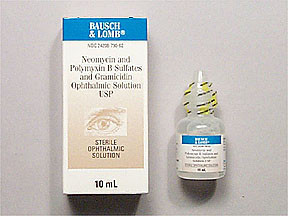NEOMYCIN/POLYMYXIN B/GRAMICIDIN D - OPHTHALMIC SOLUTION
PHONETIC PRONUNCIATION: (NEE-oh-MYE-sin/POL-ee-MIX-in/GRAM-i-SYE-din)
COMMON BRAND NAME(S): Neosporin
GENERIC NAME(S): neomycin sulfate/polymyxin B sulfate/gramicidin D
Uses
USES: This medication is used to treat eye infections. This product contains 3 antibiotics that work together to stop the growth of bacteria. This medication treats only bacterial eye infections. It will not work for other types of eye infections. Unnecessary use or overuse of any antibiotic can lead to its decreased effectiveness.
How to use NEOMYCIN/POLYMYXIN B/GRAMICIDIN D - OPHTHALMIC SOLUTION
HOW TO USE: To apply eye drops, wash your hands first. To avoid contamination, do not touch the dropper tip or let it touch your eye or any other surface. Do not wear contact lenses while you are using this medicine. Sterilize contact lenses according to manufacturer's directions and check with your doctor before using them. Tilt your head back, look upward and pull down the lower eyelid to make a pouch. Hold the dropper directly over your eye and insert one drop, usually every 4 hours, or as directed by your doctor. Look downward and gently close your eyes for 1 to 2 minutes. Place one finger at the corner of your eye (near the nose) and apply gentle pressure. This will prevent the medication from draining out. Try not to blink and do not rub your eye. Repeat these steps for your other eye if so directed, and if your dose is for more than 1 drop. Do not rinse the dropper. Replace the dropper cap after each use. If you are using another kind of eye medication (e.g., drops or ointments), wait at least 5-10 minutes before applying other medications. Use eye drops before eye ointments to allow the eye drops to enter the eye. Use this medication regularly in order to get the most benefit from it. Remember to use it at the same times each day. Continue using it for the full time prescribed. Stopping the medication too early may allow bacteria to continue to grow, which may result in a relapse of the infection. Inform your doctor if your condition persists or worsens.
Side Effects
Precautions
Interactions
Overdose
Images
Reviews
Faq for NEOMYCIN/POLYMYXIN B/GRAMICIDIN D - OPHTHALMIC SOLUTION
- Neomycin/Polymyxin B/Gramicidin D ophthalmic solution is used to treat bacterial eye infections, such as conjunctivitis (pink eye) or blepharitis.
- This solution contains three different antibiotics (Neomycin, Polymyxin B, and Gramicidin D) that work together to combat bacterial infections. Neomycin and Polymyxin B kill the bacteria, while Gramicidin D disrupts their cell membranes.
- Wash your hands before using the solution. Tilt your head back and pull down your lower eyelid to create a small pocket. Hold the dropper above your eye and squeeze out the prescribed number of drops. Close your eye and gently press your finger against the inner corner of your eye for about 1-2 minutes to prevent the solution from draining into your tear duct.
- The most common side effects include temporary stinging or burning sensation in the eyes, blurred vision, and redness. Rarely, allergic reactions or severe irritation may occur. If you experience any serious side effects, contact your healthcare provider immediately.
- This medication should not be used by individuals who are allergic to any of the ingredients or have a history of sensitivity or allergic reactions to other antibiotics. It is also not recommended for use in viral or fungal eye infections.
- Use the solution for the full prescribed duration, even if your symptoms improve. Do not stop the treatment prematurely. Contact your healthcare provider if the condition worsens or does not improve after a few days of using the medication.
- It is recommended to avoid wearing contact lenses while using the medication. Wait at least 15 minutes after applying the solution before inserting your contact lenses back in.
- If you miss a dose, apply it as soon as you remember. However, if it is close to the time for your next dose, skip the missed dose and continue with your regular dosing schedule. Do not apply a double dose to make up for the missed one.
- It is essential to consult with your healthcare provider before using this medication during pregnancy or while breastfeeding, as its safety for such situations may vary.
Disclaimer
IMPORTANT: HOW TO USE THIS INFORMATION: This is a summary and does NOT have all possible information about this product. This information does not assure that this product is safe, effective, or appropriate for you. This information is not individual medical advice and does not substitute for the advice of your health care professional. Always ask your health care professional for complete information about this product and your specific health needs.

No Reviews Yet